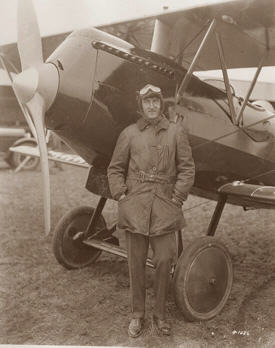 Beech with an early Travel Air open-cockpit biplane, c. 1929 |
Man's
enduring desire to fly, to probe the unknown, has produced many pioneers,
but none thrilled to the search of adventure more than Walter H. Beech.
Born on a farm near Pulaski, Tennessee on January 30, 1891, Beech's
dreams of flight began early. At the age of 14, the adventurous farm
boy built a glider of his own design using materials he found around
his own home. His mother's pride in his accomplishment probably waned
with the discovery that a portion of those materials had been
her new bedsheets. Although that particular aeronautical experiment
was a failure, young Walter was not defeated. Ten years later, on July
11, 1914, he made his first solo flight in a Curtiss biplane he and
a friend rebuilt. In 1917, when the United States entered World War I, Beech enlisted in the Army Air Corps. He served for three years as a pilot, flight instructor and engineer. Following the war, he toured the U.S. as a barnstormer, gathering ideas for improvements in aircraft design and construction.
|
| Walter
Beech came to Wichita, Kansas in 1921 to work for the E. M. Laird Company,
producer of the Laird Swallow, a three-place, tandem, open-cockpit biplane.
In attempting to demonstrate the reliability of the company's product
and thereby increase sales, Beech won numerous air races. In less than
two years, he was made general manager of the company.
Eager to obtain the freedom to put his knowledge and ideas about aircraft design to practice, he resigned in 1924 to open the Travel Air Manufacturing Company. Within four years of its opening, Travel Air became the world's largest producer of commercial aircraft. |
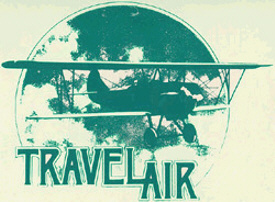 The first Travel Air plane was built in a space just 30 feet square, in a leased portion of an old planing mill. The three-place biplane proved outstandingly efficient with the OX-5 engines from war surplus, the standard power plant of the day. |
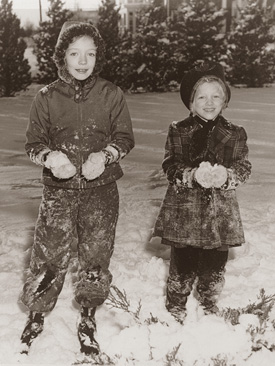 As the company grew, so did the Beech family. Suzanne and Mary Lynn brought great joy and pride to the busy lives of their parents. |
By 1929, it looked
like the aviation industry was firmly established in Wichita, but the
stock market crash that same year forced the industry into hard times.
Faced with dwindling sales, Beech merged Travel Air with the Curtiss-Wright
Airplane Company, and served as president of the airplane company and
vice-president of sales for the parent company, Curtiss-Wright Corporation.
In this new capacity, business activities kept Beech in the east.
Finding his executive duties not in keeping with his active interest in design and production, Beech returned to Wichita and founded Beech Aircraft Company in April 1932, with his wife as secretary-treasurer. Tragically, a shining star in the aviation industry winked out of the heavens on November 29, 1950. Walter Beech suffered a fatal heart attack, bringing a close to a chapter in aviation history. Friends in the industry eulogized Walter Beech as one of America's finest aircraft designers and industrialists. A shocked and saddened Wichita laid to rest one of its most illustrious citizens.
|
| Among the pioneers
of the aviation industry, the career of Olive Ann Beech stands out as
one reflecting an extraordinary combination of vision and realism. A
native Kansan, Olive Ann Mellor was born on September 25, 1903, in Waverly.
Her father, a building contractor, moved the family to Paola, where
she first attended school.
Mrs. Mellor, Olive Ann's mother, discovered a unique fiscal responsibility present in her daughter. The young Miss Mellor kept a bank account at age 7, and was given task of writing the family checks and paying bills at 11. In 1917, the Mellor family moved to Wichita, and Olive Ann Mellor attended the American Secretarial and Business College. At the age of 18, she left Wichita for employment with an electrical contracting firm in Augusta, Kansas.
|
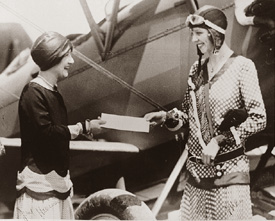 On July 27, 1928, Women's Aeronautical Association of Wichita chair June Harrison handed off greetings to sister club in Detroit to be delivered by goodwill ambassador Olive Ann Mellor. |
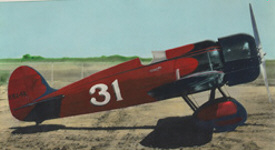 Originally named the Travel Air Model R, the Mystery Ship was the first civilian aircraft to defeat a military one, in the 1929 National Air Race, a 50-mile, closed course free-for all. |
Olive Ann Mellor's
introduction to the aviation industry came in 1924, when she was hired
as a secretary by the Travel Air Company. The only female among the
12 employees of the company, and the only one without a pilot's license,
she endured constant teasing about her lack of aeronautical knowledge.
To overcome this obstacle, she asked the chief engineer to provide her
with a detailed drawing of an airplane with all the parts labeled. She
studied the drawing thoroughly, and used the chart for many years to
instruct other young secretaries hired by the company. She also was
frequently asked why she never learned to fly. She often replied that
her instructors didn't have the right attitude. "Their idea of
instruction was to take me up and stunt the plane," she said. "In
those days, an airplane was supposedly no good unless it could fly upside-down."
|
| At Travel Air, Olive
Ann Mellor learned the business from the ground up, handling correspondence,
maintaining records, conducting transactions, and managing the office.
She was quickly promoted to office manager and secretary to Walter Beech,
in recognition of her financial and business insight.
The year following the Travel Air merger with Curtiss-Wright, Olive Ann Mellor and Walter Beech were married and moved to New York City where he assumed the presidency of Curtiss-Wright Company. Mrs. Beech was inactive in business for two years until 1932, when the couple moved back to Wichita to open Beech Aircraft Company. During her years as secretary-treasurer of Beech Aircraft, Mrs. Beech worked particularly closely with the financial side of the company, and played a key role in major company decisions. Unfortunately, Mr. Beech became ill in 1940, and he was hospitalized for nearly a year. Relying on nearly fifteen years of close work with her husband, Mrs. Beech stepped took over leadership of the company without hesitation, and steered it through that year of turbulence. One of her first fiscal actions was to arrange loans for millions of dollars to fund the company's retooling for military production.
|
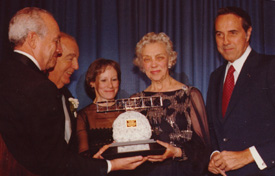 Olive Ann Beech received virtually every award the aviation industry could bestow, including the prestigious Wright Brothers Memorial Trophy. Both she and her husband were inducted into the National Aviation Hall of Fame in Dayton, Ohio, one of only two couples accorded the honor. |
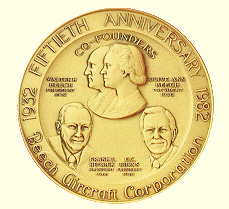 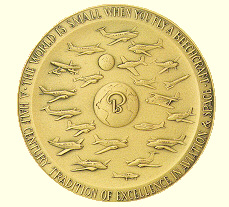 For 50 years from its establishment in 1932, Beechcraft continued its growth to the industrial prominence it enjoys today, through deliberate, planned policies of expansion and diversification, and by its early entry into the national space program. The company also developed a line of missile targets for training and acquired a wide variety of subcontracts from other aerospace manufacturers. |
After the war, the Beeches began the process of reestablishing the company's role as the world's leader in aviation. Sadly, 1950 brought tribulations to the Beech family. In June, as hostilities began in Korea, another urgent demand went out for military aviation support. In November, Mr. Beech succumbed to a heart attack. Not one to allow personal tragedy to stand in the way of their shared dreams,
Mrs. Beech once again assumed control of Beech Aircraft, as she was elected president and chairman of the board in December, at the age
of 47.
Under Mrs. Beech's able guidance, Beech Aircraft continued its growth, and through her wise policies of deliberate, planned expansion and diversification was able to again become a guiding force in the commercial aircraft industry. When Beech Aircraft Corporation merged with the Raytheon Company in February 1980, Mrs. Beech was elected to the board of directors of Raytheon. In September 1982, she retired as chairman of the board of Beech Aircraft to become the company's first Chairman Emeritus. On July 6, 1993, at the age of 89, Olive Ann Beech passed quietly away in her sleep, at home in Wichita. Her distinguished career was a tribute to the nation and the free enterprise system that made possible her rise from secretary to the esteemed position of First Lady of Aviation. |
The thousands of Beechcrafts plying the skylanes of the world and the thousands of square feet of factory buildings occupied during their manufacture are a monument to the vision and pioneering spirit of Walter H. and Olive Ann Beech. Their memory will live in the hearts of pilots as long as there are airplanes and men and women to fly them. |
Narrative by Susan Hess. |
Images in this digital exhibit may be in the public domain or under copyright which is protected by U.S. Copyright Law (Title 17, U.S. Code). Images in the public domain are made available for use in research, instruction and private study. Copyrighted materials may be used for research, instruction, and private study under the provisions of Fair Use, outlined in section 107 of copyright law. Publication, commercial use, or reproduction of a copyrighted image that does not fall under the provisions of Fair Use or the accompanying data requires prior written permission from the copyright holder. User assumes all responsibility for obtaining the necessary permission to publish (including in digital format) from the copyright holder. If publishing this image in print, electronically or on a website, for research, instruction or private study, please use the citation "Courtesy of Special Collections and University Archives, Wichita State University Libraries" and inform us of your use at specialcollections@wichita.edu. For other uses of materials, contact Special Collections. |